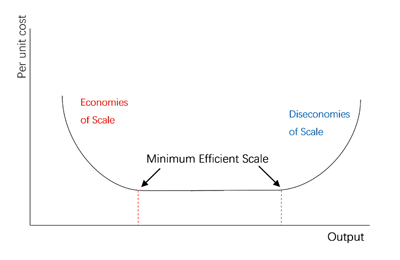The minimum efficient scale is a metric that should be understood by anyone attempting to make a profit or achieve success in business. It’s a simple tool that can be utilized by anyone attempting to sell a product or service. Everyone who fits this description has probably already completed a calculation to figure this out, whether they know it or not.
Understanding it closely, however, also gives us the ability to see where we fit into the broader market. It does this by analyzing how much output we’re able to produce efficiently against how much of a particular product the whole market is demanding. This allows us to identify where natural monopolies are occurring (or might occur). It is impossible to successfully run a business without taking the minimum efficient scale into consideration; it’s a roadmap toward viability.

What Is Minimum Efficient Scale?
Minimum efficient scale is used to determine the ideal output quantity at the lowest average cost per unit, an incredibly valuable number to have as a business owner or manager. This allows you to dictate the level of production you should be running at, how much staff to hire, and what you can expect to spend during this process.
When we were looking to develop a minimum efficient scale definition, we settled on a simple one: It's the lowest point on a long-term average cost curve. We can also say it’s where economies of scale plateau and where diseconomies of scale soon kick in.
Nearly all businesses have some costs that are fixed and do not vary based on each unit of production, and some costs that vary when output changes. (Check out our articles on Fixed Cost and Variable Cost to learn more.) The goal is to maximize your resources as well as profit margin.

Take a look at the minimum efficient scale graph above. On the left side we see the increase in efficiency, or economies of scale, as costs decrease when we raise output. The center section where the graph levels out is where we would see constant returns as output continues to increase.
Diseconomies of scale begin to kick in on the right side of the graph as companies take on more than they can efficiently manage, causing their average costs to increase.
Bigger is cheaper up to a point, and while total cost will continue to be higher as total output increases, at minimum efficient scale, the average cost will be lower, equaling ideal efficiency.
How To Find The Minimum Efficient Scale
Finding your minimum efficient scale isn’t a difficult task. You’ll take your cost per unit and your output numbers and compare them. You can draw your own graph like the one above and do some simple math to plot the points along the graph. You’ll divide your total costs by either your output number or cost per unit and find the corresponding point.
You can also experiment to discover your minimum efficient scale. If you were to double your output, the test would be to see if your returns would more than double, exactly double, or less than double. If they were to more than double, you have not yet reached your point of maximum efficiency and should continue to increase output. If they exactly double, you’ve hit your target of constant returns. You could increase output again to find the exact spot where your returns will begin to decrease. If returns less than double, you’ve gone past your minimum efficient scale, and have maxed out what is practical for you to produce.
Minimum Efficient Scale Implications
If minimum efficient scale occurs at a high enough output, there will be a natural monopoly. This is because there’s only so much demand for any given product or service in a market. There will naturally be less room for competition in this case.
It’s helpful to not only look at average cost, but also include consumer demand when considering optimal output. Maybe you can produce 600 tacos a week. Yet, if the demand in your market is only for 400 tacos, you need to take that into consideration. That's even if your minimum efficient scale sits at 500. This is unlikely because only in a monopoly can one firm satisfy an entire market’s demand. But it is an interesting part of the equation to consider. If the demand is higher than your minimum efficient scale, you’ll want to produce as much as possible. If it’s lower, adjust your output accordingly.
If minimum efficient scale occurs at a low level of output and there’s high demand in the market, there will be room for lots of firms, each achieving some level of market share.
Conclusion
The concept of minimum efficient scale is helpful for business owners and leaders. It can walk you toward the precise actions you should be taking and determine how much of the market you may be able to capture. You’ll be able to determine the specifics of what is right for you and your business based on the minimum efficient scale model provided.
We trust this article was helpful to build out your business acumen and knowledge. If you want help getting ready for consulting case interviews, find out details here.
Additional Resources:
- How Businesses Can Leverage Quantum Computing
- Automation: Threat Or Benefit?
- Circular Economy: What Is It?, Definition, Examples, & Model
- Pyramid Principle Applied